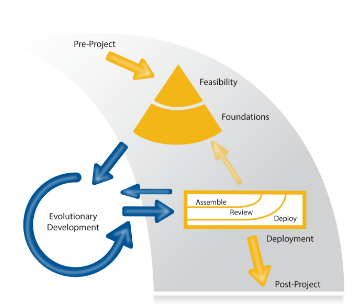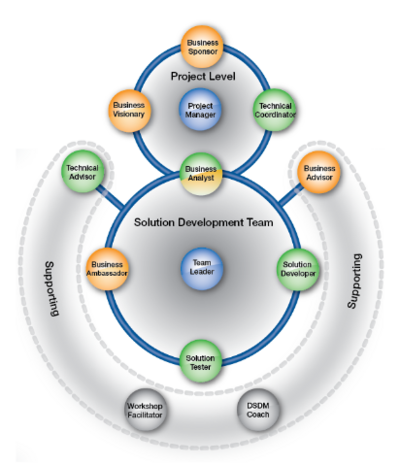Dynamic Systems Development Method(DSDM)
Contents |
Introduction
The Dynamic Systems Development Method (DSDM) is a framework for Agile project management and delivery, helping to deliver results quickly and effectively. It was created in 1994 through a collaboration of project practitioners among many companies and from that point there is a continuous evolution. Firstly, in 2008 updated in DSDM Atern and in 2014 rebranded to DSDM Agile Project Framework.[1]
DSDM is a continual and incremental approach which embrace the values and the principles of the Agile development. These values are the empowerment and collaboration between the individuals and the teams, adapt and respond to the changes and continuous collaboration between project team and the business-customer. The DSDM approach always focuses on making people working more effectively towards achieving their goals. It is an approach while initially was used only for software development through the years and its revolution can be adapted in any technical environment for any kind of project.[2] The DSDM framework is trying to face well-known problems that project managers have to address in any kind of project like ineffective communication, late delivery, unmet need through the desired solution, delayed or late Return of Investment etc.[3]
The DSDM approach is based on the philosophy:
“Best business value emerges when projects are aligned to clear business goals,
deliver frequently and involve the collaboration of motivated and empowered people”
Furthermore, one of the main assumptions in DSDM approach is that nothing can be perfected planned from the first time and instead of setting unrealistic and unreasonable expectations, a perfection of 80% could be enough at least in the beginning[4],[5].This makes DSDM to differentiate with the other traditional approaches. For instance, other traditional methods like the ‘Waterfall’ approach needs 100% perfection in order to move forward to the next step or activity which has as a result wasted time, additional effort and back and forth steps. While with iterative DSDM approach is confronted these problems, since it is not aiming for the perfection from the initial phase.
Below, it would be briefly described the basic elements of the DSDM framework. In particular, it would be mentioned the fundamental principle of the DSDM philosophy. Next, these principles are supported by a lifecycle process of 3 phases, the roles and the responsibilities, artefacts and some main techniques that are used from this approach, like Timeboxing, facilitated workshops and MoSCoW prioritization.
Principles
The DSDM philosophy is supported by 8 core principles which are focused on the business need, on-time delivery, collaboration and communication, incremental and iterative work practices, a non-compromising stance on quality and the need to demonstrate control. These principles are trying to embrace the Agile values and create a mindset to people-teams’ attitude toward to deliver consistently while remaining flexible. These principles are really critical and should be strictly followed and adopted in order the DSDM approach to succeed and exploit the full benefits of this approach. Otherwise, it cannot be delivered the best business solutions.These principles are supporting with the DSDM lifecycle process, the appropriate set of roles and responsibilities, the artefacts-products and some main practices. Below there is a brief description of these principles.[6],
[7],
[8]
[9]
1. Focus on the Business Need
When DSDM approach is following, it is important all the teams that are involved in the project to understand and focus on the business priorities and needs, since all the decisions that are making regarding the project are around how to fulfill the business needs and understand what and when to be delivered.
2. Deliver on Time
One of the main goals and success factor of a project is the delivering on time. For this reason, the teams should follow and meet deadlines by setting timeboxes which are a planned in advance timeframe but at the same time have a more variable and flexible scope in the in the pre-set deliverables.
3. Collaborate
Through collaboration can be achieved increased understanding, more efficient way of working, shared ownership which all of that will lead to increased performance. In order to be achieved a greater collaboration and fulfilled this principle, according to DSDM approach the teams firstly should empower their team members to take decision regarding the project, then engage the right stakeholder throughout the project at the right moment and finally build one team culture. In addition, all of these will be accomplished by setting the right roles and responsibilities to the right people and through facilitated workshops where their knowledge can be shared effectively with other members of the project team.
4. Never Compromise Quality
Quality is really important for a project and level of quality and expectations should be agreed in the beginning. Everyone have to aim at achieving that level of quality. So as to accomplish this goal and principle, the teams that are involved in the project should firstly agree on the level of quality of the project before its deployment, then, guarantee that quality cannot be a variable, design, and document appropriately and lastly continuously testing from an early stage of the project.
5. Build Incrementally from Firm Foundations
6. Develop Iteratively
7. Communicate Continuously and Clearly
8. Demonstrate Control
DSDM Process

Roles and Responsibilities

Artefacts
Core Practices
Conclusion
References
- ↑ [https://www.agilebusiness.org/content/introduction-0] The DSDM Agile Project Framework (2014 Onwards)
- ↑ [Craddock, A., Richards, K., Tudor, D., Roberts, B., & Godwin, J. (2012). The DSDM Agile Project Framework for Scrum.] '
- ↑ [https://www.agilebusiness.org/content/introduction-0] The DSDM Agile Project Framework (2014 Onwards)
- ↑ [https://www.agilebusiness.org/content/introduction-0] The DSDM Agile Project Framework (2014 Onwards)
- ↑ [Sunner, D. (2016). Agile : Adapting to need of the hour] '
- ↑ [https://www.agilebusiness.org/content/principles] The DSDM Agile Project Framework (2014 Onwards)
- ↑ [Moran, A. (2015). Managing Agile Strategy, Implementation, Organization and People] '
- ↑ [Craddock, A., Richards, K., Tudor, D., Roberts, B., & Godwin, J. (2012). The DSDM Agile Project Framework for Scrum.] '
- ↑ [http://www.mcpa.biz/2011/10/dsdm-atern-principals-overview/] DSDM Atern Principals – Overview